Variables are a disease of the legs that not only destroy a person's aesthetic appearance, but also lead to many serious complications.The main causes, symptoms and methods of varicose veins in the legs will be described in detail later.
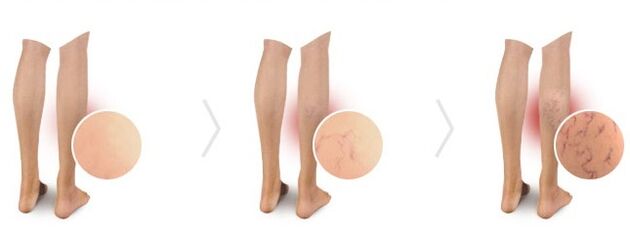
Medical Certificate - Varicose Veins
Varicocele - A chronic disease of the peripheral veins of the lower limbs.It is characterized by pathological swelling of the veins, which are manifested by the invasion of its reverse blood flow due to weaknesses in the walls of the valves and containers.Therefore, venous blood stagnates, venous pressure increases, and over time, its walls lose elasticity and begin to stretch and deform.According to the International Classification of Diseases, ICD-10 varicose veins in the lower limbs have 183.
Causes of the disease
The causes of varicose veins have not been well studied.Doctors believe that disease polysexology, but distinguish several developmental theories:
- Mechanical theory.The burden on the lower limbs is too high: with routine work (surgeons, dentists, teachers, hairdressers), athletes, pregnant women.
- Neuroendocrine theory.Due to hormone transfer (pregnancy, menopause, sexual maturity), the tone of the blood vessel wall is reduced.
- Genetic tendency.Valves in congenital inadequate valves are underdeveloped.
Risk factors for the development of varicose veins:
- female
- Genetics
- Too much weight;
- Load load;
- A sedentary lifestyle.
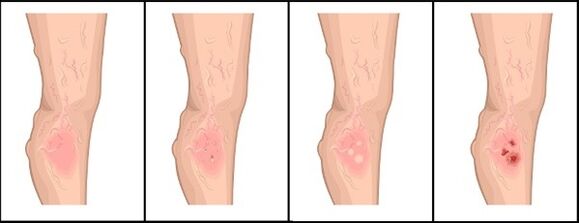
Symptoms of the disease
The symptoms of this disease are:
- The emergence of a vein grid in the form of stellar on the skin is telangioctia.
- Skin changes: dryness, pigmentation.In the late stages - dermatitis, eczema, nutritional ulcers.
- Characteristic bulge of the skin of the veins on the lower limbs.
- Symptoms of leg pain and discomfort, especially after physical fatigue.Pain may have different characteristics (pulsation, burning, soreness), when it occurs (pain at the end of the day, while walking at night).
- Edema in the calf muscles and the development of epilepsy.Initially, swelling was observed in the foot area and then applied to the lower leg.
The development stage of varicose veins
The disease develops in stages and slowly.When its first symptoms appear, it can pass for several years.
- Stage 0.It is characterized by nonspecific features such as severity and discomfort of the legs, which may be symptoms and other diseases (osseous cartilage, flat feet).At this stage, this disease is also difficult to diagnose due to the lack of the main properties and manifestations of the legs elongated vein.
- Stage 1.Changes in skin - Blood vessel stars attach to the above complaints.
- Stage 2.Enlarged swelling and meandering veins, nodules are characteristic.
- Stage 3.At the end of the day, edema occurs particularly evident.
- Stage 4.Nutritional lesions in blood vessels and legs caused by impaired vascular circulation and insufficient tissue nutrition.Strong skin pigmentation (dark brown) is the characteristic.
- Stage 5.Heal nutritional ulcers.
- Stage 6.Nutritional ulcers are contaminated.
Possible complications
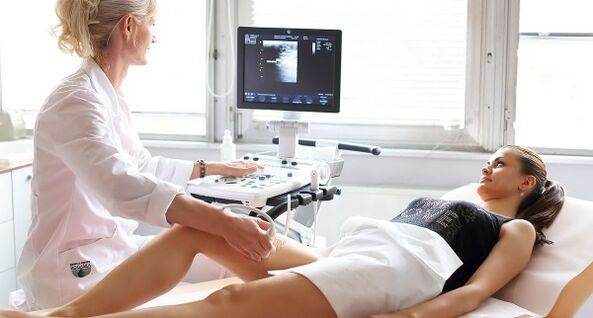
The disease itself is not life-threatening, but its complications are dangerous due to improper or improper treatment:
- Acute thrombosis of surface veins - inflammation of blood vessel walls, blood clots forming blood clots that circulate blood in tissues;
- Pulmonary artery thromboembolism - blocking the pulmonary cavity with a thrombus that cleaves from the walls of the blood vessels and usually dies;
- Venous bones;
- Nutritional Ulcers - Advanced form of varicose veins due to malnutrition in the tissue of the blood.
- Lymph node bleeding.
When to see a doctor
Varicocele veins are diagnosed and treated by vascularists (cardiovascular surgery).In order not to miss out onset of the disease, it is necessary to contact an expert on the first sign:
- the appearance of the blood vessels on the legs;
- Leg discomfort, pain;
- Swelling and rapid fatigue;
- Night twitch;
- Significantly swelling veins.
Varicocele on the legs are effective in a timely and timely manner to avoid threat complications.
Diagnostic measures
So far, the main diagnostic method is ultrasound.When diagnosing varicose veins, such measures were taken:
- Ultrasound mostly represents learning.A method that uses a combination of ultrasound and Doppler diagnosis allows you to evaluate the irritation of blood movement through blood vessels, reverse blood casting, the presence of blood clots, the condition of blood vessels in cuts, the operation of venous valves (the presence of plants), and the irritation of peripheral and deep veins.There are several types: color multi-flow technique, duplex and three-type multi-flow technique.
- Double-strand scanning (ultrasound examination) is an ultrasound multiflow technique in which two methods are used: inner mold and color doppel surgery.Allows you to determine the presence of a blood clot, its size, its nature of location, and the possibility of separation.This method is not invasive and allows for high accuracy to establish diagnosis and determine further treatment strategies.
- Flat limb metering - Method for determining blood pressure on venous walls.
- Phleboscintraphy-Introduce radiopharmaceuticals into Vienna and observe using a special device.This method is used for the combined pathology of the venous and lymphatic systems.
- Venous simulation is a radiological method that implies the introduction of an X-ray contract intravenously.In the X-ray image, the doctor will evaluate the status of the venous.When packing ultrasound multi-position, it is suitable for diagnosis of deep veins.
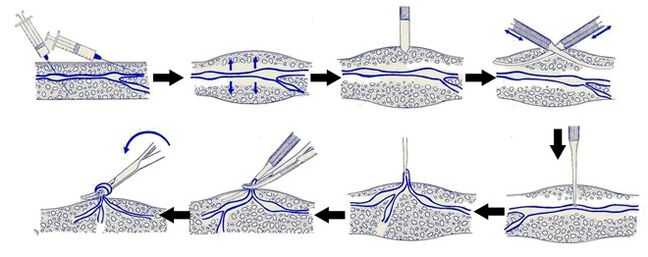
The last two methods are invasive, with many contraindications (alleviation of contrast agents), and are rarely used for diagnostic purposes today.
Treatment method
Varicocele on the legs, which is processed by two main methods in the complex (conservative and surgical) with good predictions.Conservative approach:
- Drug treatment;
- Use traditional medicine;
- physiotherapy;
- Compression therapy involves the use of special underwear;
- Sclerotherapy.
Surgery method:
- Varadi Operation - Remove affected veins (venous resection);
- Laser coagulation in the vein.
External treatment of creams, ointments and gels
In the early stages of the disease, external use of creams, ointments and gels is an auxiliary means.Preparations help reduce swelling, pain, and increase the tone of the venous walls.
Laser therapy
Lazamaria treatment (laser coagulation or ablation) is a minimally invasive method used in a distinctive form of disease.Use lasers with different wavelengths.The laser light is inserted into the cavity of the vein and stuck to its wall.In the future, such veins will be resolved.This process occurs under ultrasound control and does not leave after a strong bruise.Advantages of laser treatment: lack of recovery period, painlessness and safety of the surgery, minimal postoperative complications, scarring and pigmentation.
Sclerotherapy
Sclerotherapy - is the introduction of a special drug (sclerosis agent) into the affected vein that sticks to it from the inside and disappears over time.There are several types of this method: local echotherapy and microscopic therapy.The process lasts 20 minutes and requires 3 to 5 sclerosis treatment courses.This treatment is widely used in many countries around the world and provides long results at the initial stage (lifetime).However, with advanced and severe forms, sclerotherapy does not provide 100% guarantee.
Spa

Treatment in the form of various types of bathrooms (with herbs, salt) and showers (round, massage, contrast) helps reduce blood vessel lumens and helps relieve fatigue and swelling in the legs.
Use of stockings and tights with varico-mouthed mouth
The use of compressed (tightening) flax helps the early stages of varicose veins by eliminating blood stasis in surrounding veins and redistributes it from dilated blood vessels to healthy blood vessels.This woven linen can be used during prophylactic purposes and during rehabilitation.
Surgical therapy
Surgery to remove affected veins - Pepectomy is an aggressive, complex but most effective method (almost 100% cured).However, there are many contraindications for venectomy: cardiovascular disease, liver, kidney, pregnancy.After the surgery, one month, you will need to wear a delayed compression linen or apply elastic bandages to your legs.
physiotherapy
Use physical therapy to treat varicose veins, which are effective in preventing them in the initial stages of the disease and in complex treatments.Widely used: laser therapy, dasonvalization, magnetolaser therapy, pneumonia compression, UHF, Balneo and Mudrapy.Physical therapy helps enhance the walls of blood vessels and improves the valves, microcirculation and lymphocyte operation of the valves.Visible results can be achieved through the combination of regular course treatments with other treatments.
Folk therapy
The treatment of folk therapy for varicose veins in the legs is widely prevalent among patients.However, it should be remembered that all non-traditional medical methods are ineffective in severe forms of disease.Folk remedies for treating varicose veins:
- Tin agents for medicinal herbs: Kalanchoe, nettle, horse chestnut, ginseng root, nutmeg;
- lotion and compression made of clay; honey;
- soda water, sea salt;
- ointment (Vishnevsky);
- Hirudhotherapy (treated with medical leeches).
Using apple cider vinegar

Many experts recommend the use of apple cider vinegar to treat varicose veins.It is recommended to cook the product yourself instead of buying it in the store.To prepare vinegar, you need to grind the sweet apples and pour them 3 cm above warm water.Inject the product for 2 weeks, sometimes stirring with a wooden spoon.Strain and add a few tablespoons to a cup of water to rub.Vinegar can be rubbed into sore legs and made into compressed, wrapped, bathtub.The tool strengthens the venous walls, improves its blood circulation and reduces swelling.
Compression using lotion and clay
Emulsions and compressed forms of blue clay are often used for preventive purposes and are early manifestations of varicose veins.Dilute the powder with warm water, thicken the feet, wrap it with plastic wrap, and wrap it with a warm scarf.Retain the application for 40 minutes.Or apply 30 minutes to the gauze affected by the gauze and use chopped garlic clay.This treatment, which is frequently used (2-3 weeks), can be effective in relieving leg discomfort, swelling and fatigue.
Use tin agent for Acacia Flower
To treat varicose veins, a tin agent with white acacia color is used.To prepare it, you need to fill the raw materials with a 3-liter jar and pour 0.5 liters of vodka and medical alcohol on 1/3 and cover it with a lid.Stick to keep the mixture in a dark place for two weeks.Lubricate the sore legs every day and complete 5-7 times.tin agents will help relieve symptoms of varicose veins.
Use ginseng tin agent
Ginseng root is a natural supplement that strengthens venous blood vessels.The finished tin agent can be purchased at the pharmacy or independently prepared by pouring 0.5 liters of 150 g of crushed ginseng.Stick to keep the liquid in a dark place for 2 weeks.1-2 tablespoons of tin agent 1-2 tablespoons per day tilt inward 1-2 tablespoons.
Using nettle
The healing properties of nettle have been famous for a long time.The plant improves blood circulation, prevents blood stasis, and strengthens the walls of blood vessels.To prepare a therapeutic soup for nettle, pour a liter of boiling water on the chopped fresh or dried leaves.Stick for a few hours and be nervous.One-third soup in a glass of glass 3 times a day.
Using potatoes
Effectively, potatoes are used in the form of compressed, lotion for varicose veins.For compression, mix the freshly emitted tubers with a tablespoon of honey and apply on the sore area, secured with film and bandage on top.Keep the compression for 5 hours, then wash with warm water.The treatment process was 3 weeks.Compression helps eliminate swelling, pain, and blood vessel networks in the legs.
Prevent varicose veins
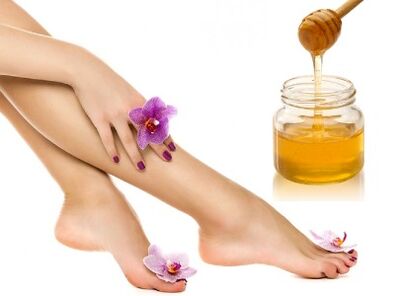
To prevent the development of varicose veins, it is worth observing the following measures, especially those at risk:
- Keep your weight normal;
- Avoid standing for a long time;
- Walk more, legs exercise;
- Shoes that are restricted to wearing high shoes;
- Limit the use of alcohol and cigarettes;
- Engage in some kind of exercise (swimming, cycling, aerobic exercise);
- Aquatic program (comparison shower, leg relaxation bath);
- Wear compressed underwear;
- Adhere to proper nutrition.
Varicocele in the legs - treatment and diagnosis - an important part of rapid recovery.To date, there are many non-traditional medicines and means that are expected to get rid of varicose veins.
If varicose veins on the legs are not ignored and treatment is initiated, the favorable prognosis ratio is very high.In the initial stages, conservative therapies are shown: medications, face creams, compressed knitted clothing, physical therapy, traditional medical recipes.In obvious form - laser ablation, removing late veins.

















